[Editor’s Note: In March, Luke Tyburski traveled to Nepal for a month to acclimate and run the Everest Ultra. He also had the fortunate opportunities to spend time with Nepalese elites Aite Tamang and Upendra Sunuwar! Enjoy Luke’s essay on his adventure.]
Reading the words “the world’s highest ultra” as I searched the Internet for my next challenge after completing the Marathon des Sables, I thought to myself, now that sounds like a fun!
In only its third year, the Everest Ultra is unlike any ultra I’d heard of before: trekking eight days from Lukla (at 9,500 feet altitude) to Gorakshep (17,000 feet) before waking up the following morning and running 40 miles back down to Lukla. Getting to the start line sounded more difficult then the actual race itself!
This would be an amazing experience, to not only see the majestic Himalayas, visit a country I’ve always wanted to explore, and say I have run down Mount Everest. I wanted to be a part of this, and had no idea what to expect!
After numerous emails with the race director Ramesh Bhattachan, he invited me to come several weeks prior to the race and spend time with some of Nepal’s talented athletes. I would be living and training with two of the country’s premier ultrarunners, Aite Tamang and Upendra Sunuwar. I packed up my running kit, GoPro, and camcorder to film it all, and headed for the Himalayas to have a Nepalese ultrarunning experience!
I was to spend the entire month of March in Nepal, having three weeks of training and acclimatisation with both Aite and Upendra throughout different locations, and then finally heading to the Everest region to trek up to Gorakshep and begin the race on March 30. This was truly a once-in-a-lifetime opportunity, and I was going to enjoy every last second of it!
___________________
I’d never been to this area of the world, but it always intrigued me with its picturesque landscapes and beautiful people. I arrived in Kathmandu, then flew onto Pokhara, the training base for Aite Tamang. He was in his final week of preparations for the Annapurna 100. (The race takes place three weeks before the Everest Ultra and is put on by the same organizer. Aite won, defending his crown.)
Small in stature and with a soft, comforting smile, my first impressions of Aite were that he is extremely polite (coming from being in the Nepalese Army, with several years of strict discipline and training, I’d guess) and has a relaxed demeanor.
I trained with him in the Pokhara region the week prior to the Annapurna 100, before we headed to his village, a two-day, four-bus-ride journey. Each morning from Pokhara, we headed out of the city and into the surrounding hills for an “easy” couple of hours running. Arriving at the foot of these mountains for the first time, I immediately felt closer to nature, as well as some forthcoming pain.
The immediate climb (which I later found out was over a mile of altitude change in just seven miles of running) was enough to make any ultrarunner become a little nervous. This was one of Aite’s usual running routes; no wonder the guy is so strong.
Like all trails in this area, and for the most part throughout Nepal, there were a combination of dirt, stones, and flattened-out, rocky paths. The switchbacks that circled up and around each peak were so steep at times, it felt like I was climbing a vertical wall.
Arriving at the summit of this climb and the site of a new Buddhist temple being built was both satisfying and rewarding. I know why they chose this location for a temple, the 360-degree views of the surrounding, lush, green valleys and ridgelines, which looked as if they floated along forever, were both spectacular and inspiring.

The view from one of the numerous trails surrounding Pokhara, Aite’s training post before the Annapurna 100.
All photos: Luke Tyburski
There are two certainties when trail running in Nepal, regardless of your location, steep, switchbacked climbs with thunderous descents, and the most magnificent views once you’ve reached a peak, summit, or clearing. Absolutely marvelous!

One of the many harsh switchbacks in the Pokhara area.
An interesting observation, though, of the Nepalese general public’s attitude toward running was that it was crazy and insane. Although arguably the world’s best mountain guides, the Sherpas all felt the same way, that there is no point in running, that people should relax and walk. This is yet another obstacle put in front of these gifted runners as they try to succeed in a sport where even their own countrymen, let alone government for funding, do not give any support.
___________________
I was excited and nervous to be spending time in the villages of Nepal, seeing how the people in these remote places live, eat, and go about their daily lives.
Climbing down from the roof of our fourth and final bus ride, Aite pointed up to the top of a neighboring hill and said, “I live there.” After nearly two hours of non-stop trekking straight up the hill, in the dark, and with no head torches, we arrived at Aite’s family home.

Aite and other locals traveling “rooftop” to his village.
What happened next I’ll never forget. It was dark so I couldn’t really get a look at the house or its surroundings, but as soon as Aite opened the creaky, wood-paneled door, I was engulfed with smoke as I moved into the single-room house. I could barely make out that there were four people sitting on the floor around a fire that had recently been lit to cook dinner.
When Aite is not away training for a race, he stays here with his wife, daughter, mother, and father. This split-level home, with its mud floors, is shared by all. This included the buffaloes, goats, and chickens who were sleeping barely five feet away from where I was sitting, using my hands to eat my first meal in a Nepalese village, a traditional dal baht (cooked rice with a lentil dahl and an arrangement of seasonal vegetables).

Aite’s family home, perched on the side of a hill at 6,000 feet above sea level.
The next morning, we set off running. We followed a ridgeline up and down, along the loose, gravel trails, before heading along what only could be described as a dense forest until reaching peaks of 10,000 feet.
It felt like we were gods running into the clouds, with the clear, blue sky our destination. Running here, along the tops of these tree-lined trails with distant views of snow-capped Himalayan mountains, was peacefully challenging. A certain calmness came over me with every step.
Although Aite’s home had no running water, electricity, or plumbing, his family was extremely happy with their lifestyle. Aite lived in an ultrarunner’s dream location, and being the first Westerner to step inside his house, I felt extremely privileged and honored.
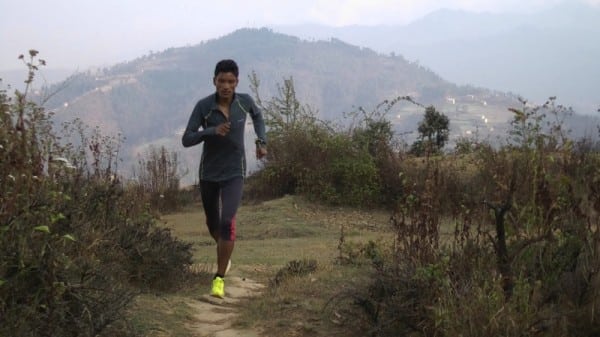
Aite Tamang training in his village.
_________________________
Finally, after two buses from Kathmandu, with the second bus a four-hour, windy ride clinging to a cliff’s edge, Upendra and I began walking along a dried-up river bed. He pointed to a distant peak hiding behind three others and said, “My house is on the other side of that mountain.” I laughed, as I thought he was joking. He wasn’t joking. Four-and-a-half hours later and seven miles walked, with just over a mile climbed in elevation, we headed out onto a ridge where Upendra’s six-home village sat.
His family home was in a similar mold to Aite’s, although his parents had an adjacent building that was a barn for the animals. Once again, Upendra and his family had never welcomed another person from a foreign land into their home, but they openly embraced my visit and made me feel part of their family. I was touched.
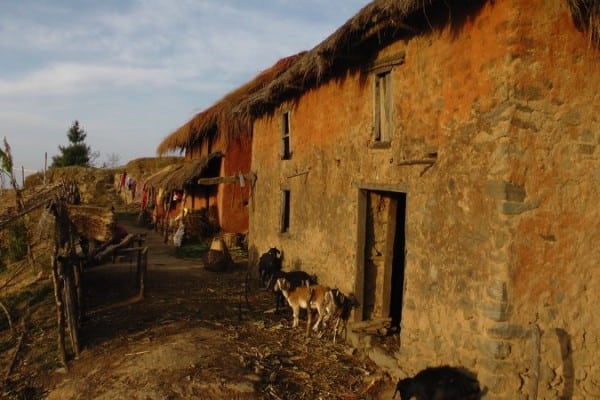
Upendra’s family home, with the “garbage-disposal units,” the goats.
The views across the valley where Upendra’s home sat perched along a ridge were vast and mesmerizing. The area had a lot of solid-ground trails, with occasional, thin, loose, rocky paths to run along. Each day we ran for hours over undulating trails, taking sharp turns onto other routes. Most of the time I didn’t even notice the small slither of trail that connected onto our current route.
These detours would take us on a one-way route into the heavens, zigzagging our way up and over large rocks, which had fallen from above and become lodged on the trail in years past, and fallen trees, which Upendra told me had been hit by lightning. We ran, jumped, hopped, and then walked some of the incredibly steep ascents, through thick bush and dodging trees and low-hanging branches along the trail, before finally reaching the summit and its awe-inspiring views.
Back at Upendra’s home, his mum prepared lunch for our return, another take on the traditional dal baht, with the vegetables being what the family had grown, spinach and potatoes.
Upendra’s parents grow what they need, swap or barter for anything else, and visit a near by market once a month for larger staples like rice and legumes. A simple, organic diet, the food looked, smelled, and tasted like I’d never had before. This was food at its purest and freshest form.
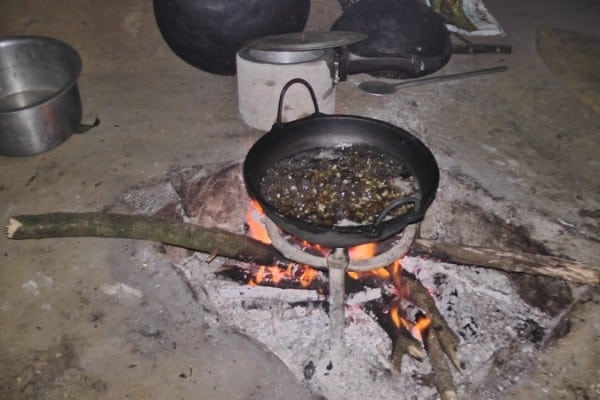
Cooking dahl with Upendra’s mum. The woman CAN cook!

With Upendra’s parents at their family home. (I’m 6”1.)
_________________________
I learned so many different training techniques from both of these guys. Upendra likes to “go long.” He will just head out early in the morning and cruise along for the entire day, stopping at small villages to hydrate and snack. Occasionally, he’ll do a shorter session of just five or six hill-climb repeats, but mostly he just loves running all day long.
Aite, on the other hand, has a more structured training week. I was surprised to hear that Aite’s training is similar to many Western ultrarunners, although he has never been coached. Long runs, intervals, recovery, and hill/strength runs were all part of his weekly regime, as was his post-run nap! Upendra would only occasionally nap after a run; he just never felt he needed to. Two very different training weeks by these extremely talented athletes who’ve achieved some amazing results. It’s awesome how completely contrasting approaches can still deliver spectacular runners!
I asked both for some advice on trail running, and they both gave me similar responses. “Slowly, slowly,” would be the cry whenever we reached the start of a climb that soared into the sky. And, “careful, careful,” I would hear while shooting down each twisted descent while running as fast I could to keep these guys in my sights. Not going too hard at the beginning of climbs and not crashing while running downhill were their basic points.
The final piece of advice they both agreed on was that whenever there was what they deemed a flat stretch of trail, they said, “If you feel good, you go faster!” I felt good most of the time on these flatter sections, but my perception of faster was a little different from theirs. Mine was an increase of pace, theirs was an all-out sprint to the next hill!
Aite, Upendra, and Nepal have all highlighted how important it is to enjoy and embrace the simple things in life. These two men live in a poverty-stricken country, have very little money, but are driven by passions for the mountains and running. Their families do what they can each day to survive, and then awake the following day to do it all over again. The hopes and dreams of Aite and Upendra are to support their own families by moving up in the ultrarunning world, winning international races, and supplying food and supplies in order to keep their loved ones well fed and healthy.
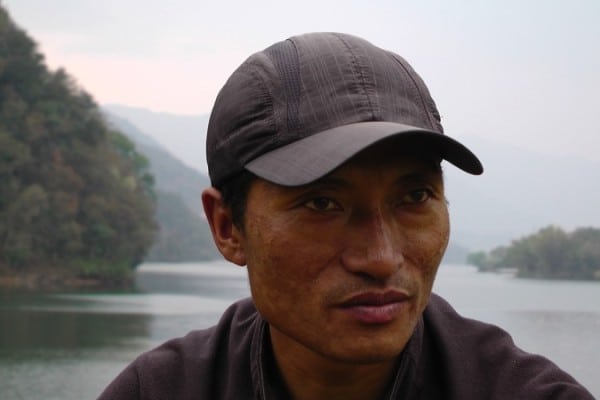
Upendra Sunuwar, the face of a seasoned runner.
___________________
The 65-kilometer Everest Ultra is more than just a race. It’s an experience, and one of the reasons I came to Nepal was to test myself racing down the mighty Mount Everest. As the world’s highest ultra, starting at Gorakshep (not far below Everest Base Camp) at 17,000 feet and finishing at 9,500 feet, this alone exemplifies how tough the race is. But the toughest parts of the entire experience are trekking to the start line and arriving fit and healthy!
I set off with several other foreign runners, the race director, and a couple of Nepali runners (including Aite) from Kathmandu on a tiny aircraft. We all headed not over but through the hills surrounding Kathmandu, and then between snow-capped Himalayan peaks. This was an eerie feeling as we approached what’s deemed the world’s most dangerous airport, the Tenzing Hilary Airport in Lukla. We were flying well below several summit lines, with many not far away. After landing and stopping quite abruptly on the extremely short and sharply inclined runway, it was time to start of our eight days of trekking!
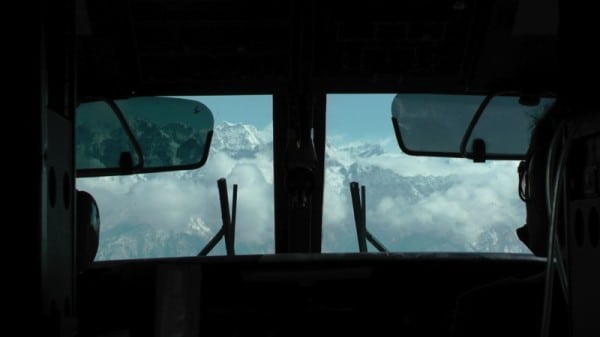
Approaching the runway at Lukla. Yes, I’ve no idea where it is either.
Each day we trekked for several hours, ever so slowly getting higher and higher in altitude. We stayed in modest lodges which were filled with other trekkers both who were “heading up” or “coming down.” The evenings in these dwellings were filled with storytelling of the days adventures.
We hit 13,000 feet with the majority of our party now feeling some of the effects of altitude. We knew just how tough this race was going to be, and we each questioned our sanity at this point!
Each day we were treated with views of Himalayan peaks and glaciers which spread over vast areas with wave-like formations due to the high winds. Spectacular is one word that comes to mind when describing the forever-changing scenery.

Prayer flags and a Himalayan peak at a memorial site between Dughla and Lobuche.
We reached Lobuche, and only two days until it was time to race! Several other Nepalese runners joined us here, with Upendra arriving after only two days of travel from Lukla. We all took six!
At 16,000 feet, everyone was struggling from mountain sickness in some way, and we had already lost two runners through altitude sickness and a stomach virus. They were on their way back down to Lukla. I was feeling strong, excited, and ready to test myself and use all the skills, techniques, and advice my two Nepali running coaches had taught me.
But, instead, I woke up the following morning feeling horrendous; I had a terrible night, constantly running to the bathroom and unable to keep anything inside of me. Now, without any food or fluids in my body and combined with altitude sickness, I was weak, dehydrated, but determined to make Gorakshep and the start line tomorrow! I made Gorakshep after an extremely slow day of trekking and laid down to rest. I knew that I was in trouble when again I could not hold down or keep in any food or fluids.

The author at Gorakshep 20 hours before race, trying to consume some food. It didn’t go down well.
At 7 p.m. that evening, 11 hours before the race was scheduled to begin, a decision was made to get me down the mountain to a lower altitude to combat my ever-increasing altitude sickness. Normally I would have fought this decision as it meant not starting the race, but I was out of it and had no idea what was happening to me. I put on a jacket as it was freezing outside and headed back down the mountain in the pitch-black night with a local guide. Two-and-a-half hours later, I arrived, dragging my feet, and following my guide into Dughla at 15,000 feet. This was my pit stop before my epic challenge of getting back down to Lukla tomorrow.
Although I was not officially starting the race, I still had to travel the 35 miles to Lukla via the race course, and there was only one way to do this: on my own and in a slow combination of walking and running. At 6 a.m., I stumbled out of the lodge where I barely slept, still unable to eat or drink anything. My plan was to walk the first few hours, and then attempt to run a little when my body would allow me. My guide headed back up the mountain as I started my long and lonely day.

Porters carrying supplies up to Everest Base Camp.
As the Nepalese runners flew by me around 8:30 a.m., the leaders of the Everest Ultra coming downhill from Gorakshep, I was inspired to try and jog. My head shook, my stomach churned, and my legs ached. Running was painful on so many levels. I knew I had no other choice, so I knuckled down, embraced the pain, and continued a run-walk strategy. I continued in this fashion for several hours, becoming weaker with each passing race checkpoint. I was still unable to keep any food or liquids down. This was a worry, but so was the fact that, when I had 13 miles to go, my body hit near meltdown.
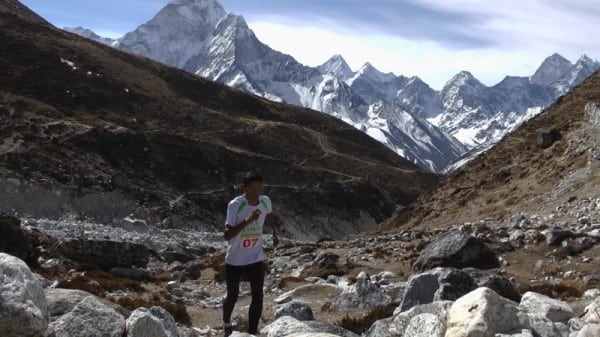
Aite Tamang running at Dughla during the Everest Ultra.
With only five miles to go, just as I thought things couldn’t get any worse, the heavens opened and it began to pour down with rain. I was now soaked. Whatever spirits I had left were being pulverized into the mountains’ floor with each raindrop. I did the only thing I could think of, laugh!
I reached the final climb up into Lukla, what a way to finish the 10 hours of torture I just put myself through! Dripping wet and fueled on nothing more than determination, I crossed the finish line and immediately went into our lodge to sit down. This felt like all my Christmases and birthdays had come at once!
Although I didn’t officially compete in the Everest Ultra, I still feel I got a lot out of the experience. (Maybe even a little too much.) It’s a demanding race, spaced out over nine days, with breathtaking views the entire way. Anyone who loves running, the mountains, or a challenge should experience Himalayan trail running at least once in their life. And if you fancy competing in the world’s highest ultra, just remember that it’s not the 40-mile race that is the tough part, it’s getting to the start line healthy!
- It was confirmed that I had giardiasis on return home to the UK.
- My documentary for this Nepalese ultrarunning experience will be out in 2014. Check my website for updates of release date.
- If you are interested in sponsoring or learning more about Aite and Upendra, please contact me at [email protected].
